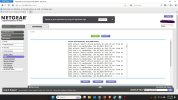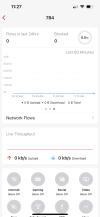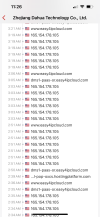You forget which site you on LOL.
I would say most here do not have internet connected TVs, IoT toasters or use Siri or Alexa LOL. Heck I turn wifi and data off on my phone unless I am actively doing something that needs it LOL.
I do have a streaming device but it is only plugged in when in use (yeah I am anal LOL) and is on its own VLAN with no access to anything else on my system.
And like I have said previously, of course a Windows PC is a target rich environment for hackers because there are so many Windows computers out there compared to NVRs. But it has practically daily updates to the OS and antivirus software to help combat it and close off vulnerabilities as they are found.
How often do NVRs and cameras have firmware updates? Not often. And when there is one, it is usually for a vulnerability that was discovered over a year prior.
One of the things that led me to this site was my NVR being hacked using P2P.
One of my
friends printers and Foscam camera was hacked by P2P. As some point Foscam issued a security vulnerability and issued a firmware update. Basically the vulnerability was when logging into the camera with a web browser over HTTPS, the initial login to the P2P site is done using SSL. But then it establishes a connection to the HTTPS port again (for the media service) and sends all of its commands unencrypted. This means the username and passwords were being sent unencrypted. While this was a security vulnerability found in Foscam, every manufacturer has issued a firmware update for vulnerabilities, including
Dahua or they wouldn't have shut down older P2P servers. I suspect this is how my friend was hacked and someone was sending pictures of her taken from her Foscam camera to her printer that she set up using P2P.
What is ironic is even
Dahua suggests not to use P2P in their cybersecurity best practices....
Now granted they say it is highly unlikely if someone doesn't have the system username, password, and serial number, but it doesn't mean it won't happen in the future when some hacker finds another backdoor or exploit. But nonetheless, they are acknowledging it is a concern/risk.
But to completely dismiss the potential concern about P2P and blindly accept P2P when there are folks here like myself and others that have been hacked using P2P isn't doing a service to the forum community either.
Just because you haven't been hacked doesn't mean it can't happen. Fortunately you have a firewall device and monitor your system to know if/when it was attempted or happened, but many do not and find out much later.
Everything in life is a risk. Some people smoke and never get cancer, but it doesn't mean others don't or won't. Some people never get a speeding ticket, but it doesn't mean they won't or that others haven't. Some people have gasp used port forwarding and have never been hacked, but it doesn't mean others haven't.
But I do think we have a duty to inform what the risks are of each scenario.
The only way to completely prevent hacking is to not allow the device to connect to anything and truly be a CCTV system.
But that is unrealistic to most.
Most here will agree that port forwarding directly to the NVR is the least safe. Although the great internet has many articles that state it is OK lol like
whatismyipaddress.com that states:
"Port forwarding is an excellent way to preserve public IP addresses. It can protect servers and clients from unwanted access, "hide" the services and servers available on a network, and limit access to and from a network. Port forwarding is transparent to the end user and adds an extra layer of security to networks. In short, port forwarding is used to keep unwanted traffic off networks. It allows network administrators to use one IP address for all external communications on the Internet while dedicating multiple servers with different IPs and ports to the task internally. Port forwarding is useful for home network users who may wish to run a Web server or gaming server on one network."
Then there is a debate as to if P2P or OpenVPN or something like ZeroTier is the next safer option.
Arguments are made both ways.
P2P you are relying on the NVR manufacturer's servers to not be hacked. You have zero control over those. Dahua has recently been shutting down the older P2P servers that were more easily hacked.
Same with ZeroTier or Wireguard or Tailscale and the like. You are relying on someone else's servers to make that connection. Anytime you are relying on someone else, it can be
hacked.
OpenVPN is hosted locally, either native to the router or installed on a computer.
In theory you have the most control over this since it is all in your house.
But it relies on opensource coding that can be
hacked as well.
You are relying on your computer and router to be up to date and not allow bad actors in. And sadly, like NVRs, routers are not routinely updated either. But that is the same regardless of the solution you are using.
So you take extra steps like the
firewall device @bigredfish has that allows you to monitor everything.
Take steps to further minimize access to stuff.
Regardless of which platform you use to access your stuff remotely, have it be isolated from the rest of the system so that the entire system isn't compromised.
Set up procedures that lets you know whenever something connects or logs in to your device. Doesn't necessarily prevent the backdoor exploit, but take any steps possible to eliminate those risks.
Or just say F it and use port forward and scanning QR codes blindly like most of society. At the end of the day, most don't get hacked. It just sucks if you are one of them that do.













